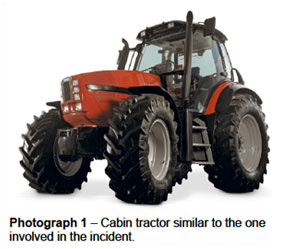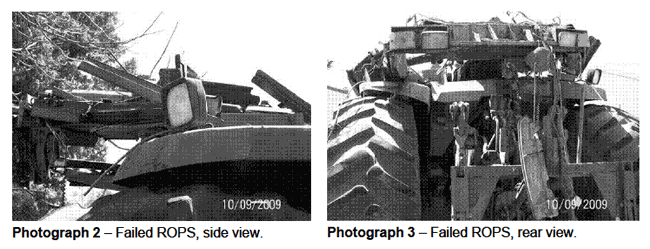Tractor roll over protective structure limitations
Issued: 26 May 2010
Last Updated: July 2024
Purpose
To alert plant owners/operators, including workers, employers, self employed persons and suppliers, of the circumstances that led to a tractor driver sustaining fatal injuries when the roll-over protective structure (ROPS) attached to the tractor failed during a roll-over incident on a sealed road.

Background
A 180 hp tractor towing a 7.8 tonne trailer was travelling at approximately 20 km/h along a single lane bitumen road. To enable a vehicle to pass, the tractor was driven to the side of the road which was corrugated with a sharp drop off and steep drain nearby. When driven back onto the road, the attached trailer slipped down the steep incline into the drain pulling the rear of the tractor sideways. This caused the tractor to roll over, which resulted in the failure of the ROPS fitted to the tractor (refer to photographs 2 and 3 below). The driver suffered fatal injuries.

The ROPS test report, provided by the tractor manufacturer, indicated that the ROPS was tested in compliance with Code 4, OECD Standard Code for the Official Testing of Protective Structures on Agricultural and Forestry Tractors - Static Test.
The Code sets minimum standards for which the ROPS must comply and is an acceptable standard for ROPS used on tractors in Australia.
The criteria and tests in the Code provide an equivalent level of safety when compared to the criteria in AS 1636.1-1996 Tractors–Roll-over protective structures–Criteria and tests–Conventional tractors.
The test report of the ROPS fitted to the tractor involved in this incident showed that the ROPS complied with the requirements of the code.
The manufacturer also confirmed that the serial number of the ROPS fitted to the tractor at the time of the incident was the same as that fitted at the factory during manufacture. There was no evidence of modification, corrosion or pre-existing damage to the ROPS that may have contributed to the failure.
Calculations have shown that the energy of the combined masses of the tractor and trailer travelling at 20 km/h would be in excess of that required by the code and could not be dissipated by the ROPS.
Significant contributing factors to this incident were the speed and mass of the tractor and trailer combination, as well as the use of castor steering (shopping trolley steering) on the front axle of the trailer.
Hazard
The hazard associated with this incident is the potential for ROPS to fail if the tractor is operated at excessive speeds for the conditions or for the towed attachments.
Risks
The risk associated with this incident is the likelihood that the operator of a tractor may sustain crush injuries resulting from failure of the ROPS when operated at excessive speeds for the conditions or for the towed attachments.
Recommended control measures
Tractors have a high centre of gravity. Excessive speed, operating on steep inclines, executing sharp turns and attaching high or unstable loads can cause a tractor to roll over.
ROPS do not prevent a roll over; however they do reduce the risk of fatal injuries for the operator if the tractor rolls in a low speed single roll over situation. It is important that seat belts are worn when ROPS are fitted to enhance occupant safety.
Engineering
Tractor ROPS are designed to a standard that does not afford protection for roll-overs that exert a force to the ROPS in excess of what is prescribed in Code 4, OECD Standard Code for the Official Testing of Protective Structures on Agricultural and Forestry Tractors. Trailers and other towed implements must include a positive connection to any steering axle to prevent the trailer from applying a side load to the rear of the tractor during travel.
Brakes must be fitted to trailers where the weight is greater than the maximum un-braked towing capacity specified by the tractor manufacturer. When operated on a public road, the trailer should comply with applicable transport legislation.
Administrative
Operators must be aware of the limitation of the ROPS design and the risk associated with the operation of tractors at speed, particularly when towing trailers and other items of plant.
A tractor must only be used for its intended purpose. Operating a tractor at excessive speed and/or towing of a trailer, changes the operating characteristics of the tractor and the manufacturer should be consulted to ensure that the tractor is designed for the intended purpose.
Excessive speed, operating on steep inclines, executing sharp turns and attaching high or unstable loads can cause a tractor to roll over.
Operators should receive training in the risk factors associated with the operation of tractors, with reference made to the information provided in the Rural plant Code of Practice 2024 (PDF, 1.73 MB).
Legislative requirements
The Work Health and Safety Act 2011 applies duties on persons conducting a business or undertaking to ensure:
- the health and safety of their workers
- any other person is not affected by the conduct of the relevant person's business or undertaking
- their own workplace health and safety.
This can be achieved in part by, providing and maintaining safe plant, ensuring safe systems of work and providing information, instruction, training, supervision to ensure health and safety.
For practical advice on managing exposure to risks when using plant, visit the Workplace Health and Safety Queensland website for information on:
- Rural plant Code of Practice 2024 (PDF, 1.73 MB)
- How to manage work health and safety risks Code of Practice 2021 (PDF, 0.65 MB)
Further information can be reviewed by visiting the following non-government websites: